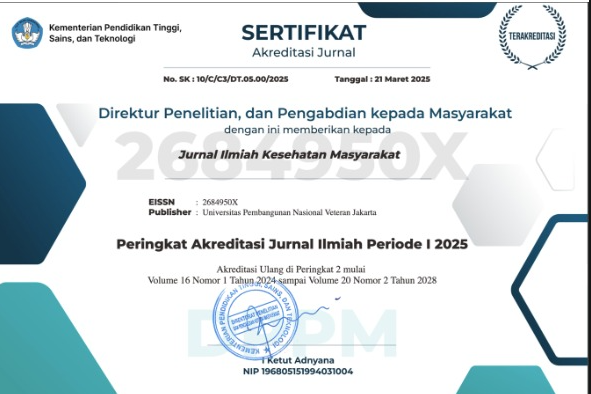Hubungan antara Kecukupan Energi dan Protein dengan Prevalensi Anemia pada Wanita Usia Subur di Kecamatan Ciampea Bogor
Abstract
Abstrak
Latar Belakang: Anemia adalah suatu kondisi rendahnya konsentrasi haemoglobin dibawah standar. Anemia pada wanita usia subur (WUS) dihubungkan dengan tingginya resiko melahirkan bayi berat lahir rendah (BBLR) serta kematian ibu dan bayi. Asupan energi dan protein berhubungan langsung dengan status anemia, namun ketidakkonsistenan masih sering ditemukan, sehingga studi ini bertujuan untuk mengkaji hubungan kecukupan energi dan protein dengan status anemia WUS (15 – 44 tahun).
Metode: Studi ini menggunakan desain cross sectional yang melibatkan 586 WUS di Kecamatan Ciampea, Bogor yang direkrut dengan metode multi cluster random sampling. Pengambilan data dilakukan menggunakan kuesioner terstruktur dan data yang didapatkan diolah menggunakan SPSS 20.
Hasil: Hasil menyatakan ada hubungan antara kecukupan protein dengan kejadian anemia pada WUS (OR=0.52, p=0,01). Lebih lanjut, ditemukan bahwa tidak ada hunbungan yang bermakna antara kecukupan energi dengan kejadian anemia.
Kesimpulan: Prevalensi anemia pada WUS di Kecamatan Ciampea, Bogor sebesar 32,9% yang berhubungan dengan kecukupan asupan protein. Wanita dengan konsumsi protein cukup lebih kecil resikonya untuk menderita anemia.
Associations between Energy and Protein Adequacy with Prevalence of Anemia among Indonesian Women of Reproductive Age in Ciampea Sub-district Bogor
Abstract
Background: Anemia is a condition of low hemoglobin concentration below a certain cut-off points. Anemia occurrence among women of reproductive age (WRA) is linked to a high risk of low birth weight, premature death, and maternal mortality. Energy and protein intake, classically related to the anemia, however, the inconsistency still exists, so that the objective of the current study is to assess the association of the energy and protein intake adequacy to anemia status of women of reproductive age (15 – 44 years old).
Methods: The design of the study is cross-sectional that involved 586 WRA in Ciampea Sub-district, Bogor that is recruited by multi-cluster random sampling. A structured questionnaire was used for data collection. Data were analyzed using SPSS 20.
Results: There is an association between protein intake association with anemia status of WRA (OR-0.52, p=0,01). Further, it has shown no significant association between energy intake adequacy with anemia status.
Conclusion: Anemia prevalence among WRA in Ciampea Sub-district, Bogor was 32.9% that is associated with protein intake adequacy. Women with adequate protein intake were less likely to be anemic.
References
USAID. Anemia prevention and control: what works. United States; 2003.
World Health Organization. Haemoglobin concentrations for the diagnosis of anaemia and assessment of severity. Switzerland: World Health Organization; 2011. Report No.: WHO/NMH/NHD/MNM/11.1.
Balarajan Y, Ramakrishnan U, Ozaltin E, Shankar A, Subramanian S. Anaemia in low-income and middle-income countries. 2011;378:2123–35.
World Health Organization. The Prevalence of Anemia in Women. Switzerland: WHO; 1992.
USAID. Anemia Prevention and Control: what works. Interagency Anemia Steering Group; 2003. 77 p.
World Health Organization. World Health Assembly: Global Nutrition Targets 2025: Anaemia Policy Brief. 2014.
World Health Organization. Iron Deficiency Anaemia Assessment, Prevention, and Control: A guide for program managers. 2001.
McLean E, Cogswell M, Egli I, Wojdyla D, de Benoist B. Worldwide prevalence of anaemia, WHO Vitamin and Mineral Nutrition Information System, 1993-2005. Vol. 12, Public health nutrition. 2009.
Food Agricultural Organization. The role of iron in human metabolic processes. Agriculture and Consumer Protection; 2011.
Hanan S, Gilani A, Haq U. Anemia in adolescent college girls: effect of age, nutritional status and nutrient intake. 2010;62:204–10.
Singh RK. Lifestyle behavior affecting prevalence of anemia among women in EAG states, India. 2013;279–88.
National Cattlemen‘s Beef Association and Cattlemen‘s Beef Board. Enhance Your Absorption of Iron. 2001;
National Institutes of Health. Your Guide to Anemia. United States; 2011.
Cepeda-Lopez AC, Osendarp SJM, Melse-Boonstra A, Aeberli I, Gonzalez-Salazar F, Feskens E, et al. Sharply higher rates of iron deficiency in obese Mexican women and children are predicted by obesity-related inflammation rather than by differences in dietary iron intake. Am J Clin Nutr. 2011;93(5):975–83.
Qin Y, Melse-Boonstra A, Pan X, Yuan B, Dai Y, Zhao J, et al. Anemia in relation to body mass index and waist circumference among Chinese women. Nutr J. 2013;12(1):10.









.jpg)








